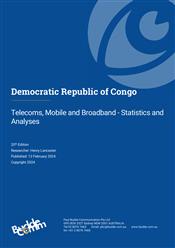Democratic Republic of Congo Telecoms Market Report
Telecoms, Mobile and Broadband - Statistics and Analyses

Last updated: 12 Feb 2024 Update History
Report Status: Current
Report Pages: 160
Analyst: Henry Lancaster
DRC sees 5G trials though MNOs await more spectrum availability
The Democratic Republic of Congo (formerly Zaire) has had a tortuous history since gaining independence. The country’s stability has been affected by disputes among rival groups and armed militias, particularly in the far eastern provinces and Katanga. This has resulted in considerable social upheaval, exacerbated by extensive levels of corruption within the government.
The national telecom system remains one of the least developed in the region. The government can only loosely regulate the sector, and since the national telco SCPT has little capital to invest, much of the investment made in infrastructure is derived from donor countries or from the efforts of foreign (particularly Chinese) companies and banks. Efforts have been made to improve the regulation of the telecom sector, with a revised Telecommunications Act adopted in May 2018. However, the practical implementation of the Act’s measures remains questionable. Indicative of the character of the market is the levy on mobile devices imposed in 2020. While nominally intended to help address fraud, the levy has been widely condemned by consumers as a tax which has enriched a few. This sentiment has not been helped by the fact that the funds levied through to December 2021 could not be accounted for in government accounts. The government adopted a decision to scrap the levy, repealing the legislation effective from March 2022.
Similarly, funds raised thus from the revenue of licensed telcos to be expended via the Universal Services Development Fund (FDSU) have yet been disbursed, though there have been repeated calls for the Fund to become operational.
Given the limited and decrepit condition of fixed-line infrastructure the mobile network operators have become the principal providers of basic telecom services. More than a dozen new licenses were issued in the early years of the century, but many of the licenses failed to launch services and the proliferation of networks - as well as the poor monitoring of spectrum assets - caused frequent problems with spectrum shortages, interference, and compatibility issues. As a result, the mobile sector entered a period of consolidation, including the acquisition of Tigo Congo by Orange Congo in April 2016.
The development of the DRC’s internet and broadband market has been held back by the poorly developed national and international infrastructure. However, the country was finally connected to international bandwidth through the WACS submarine cable in 2013, while SCPT continues to roll out a fibre national backbone network with support from China. In recent years, more cable connections have greatly increased available internet bandwidth.
The country’s first commercial LTE networks were launched in May 2018 soon after LTE licenses were issued. Though geographically limited, and with less than half of the population covered, the MNOs are keen to develop mobile data services and capitalise on the growth of smartphones usage. Orange and Vodacom have both started trials of 5G, though the commercial launch remains some way off, partly because LTE networks can satisfy existing data demand, and partly because the operators lack suitable spectrum in the higher frequency bands.
Key developments:
- Thunes teams with the local bank Rawbank to facilitate cross-border m-money transactions.
- Africa Digital Academy signs an MOU with the Digital Development Agency to train public administration employees in cybersecurity, AI, and digital transformation.
- Vodacom starts 5G trials, though the operator’s principal focus is on extending its 3G and LTE networks.
- Eastcastle Infrastructure secures funds to build a network of towers to be leased to the DRC’s MNOs.
- Africell extends mobile network coverage to three more provinces, covering an additional four million people.
- Report update includes operator data to Q4 2023, the regulator’s market data to June 2023, updated Telecom Maturity Index charts and analyses, recent market developments.
Companies mentioned in this report:
Vodacom Congo, Bharti Airtel (Zain, Celtel), Millicom (Tigo), Congo Chine Telecom (CCT, Orange Congo), Africell (Lintel), Société Congolais des Postes et des Télécommunications (SCPT), Tatem Telecom, Gecamines, AfriTel (Starcel), Standard Telecom, Telecel International, Africanus.net, Interconnect (Vodanet), Microcom, Cielux Telecom, Global Broadband Solution (GBS), Afrinet, Congo Korea Telecom, Geolink, ICP Net, Orioncom, PacoNet (Pan African Communication Network), RagaNet, Roffe Hi-Tech, Sattel, Société Internet Congolaise (SIC), Sogetel, Liquid Telecom, O3b Networks, Smile Telecom, Alcatel-Lucent, Ericsson, Huawei Technologies, ZTE.
Related Reports
- Africa - Fixed Broadband Market - Statistics and Analyses
- Africa - Mobile Infrastructure and Mobile Broadband
- Africa - Mobile Network Operators and MVNOs
- Morocco - Telecoms, Mobile and Broadband - Statistics and Analyses
- Sierra Leone - Telecoms, Mobile and Broadband - Statistics and Analyses
- Senegal - Telecoms, Mobile and Broadband - Statistics and Analyses
- South Africa - Telecoms, Mobile and Broadband - Statistics and Analyses
- Zambia - Telecoms, Mobile and Broadband - Statistics and Analyses
- Rwanda - Telecoms, Mobile and Broadband - Statistics and Analyses
- Uganda - Telecoms, Mobile and Broadband - Statistics and Analyses
Share this Report
TMT Intelligence
A platform to scale your intelligence tasks
Monitor critical insights with our AI-powered Market Intelligence Platform gathering and analyzing intelligence in real time. With AI trained to spot emerging trends and detect new strategic opportunities, our clients use TMT Intelligence to accelerate their growth.
If you want to know more about it, please see:
Research Methodology
BuddeComm's strategic business reports contain a combination of both primary and secondary research statistics, analyses written by our senior analysts supported by a network of experts, industry contacts and researchers from around the world as well as our own scenario forecasts.
For more details, please see:
More than 4,000 customers from 140 countries utilise BuddeComm Research
Are you interested in BuddeComm's Custom Research Service?
Hot Topics
News & Views
Have the latest telecommunications industry news delivered to your inbox by subscribing to BuddeComm's weekly newsletter.